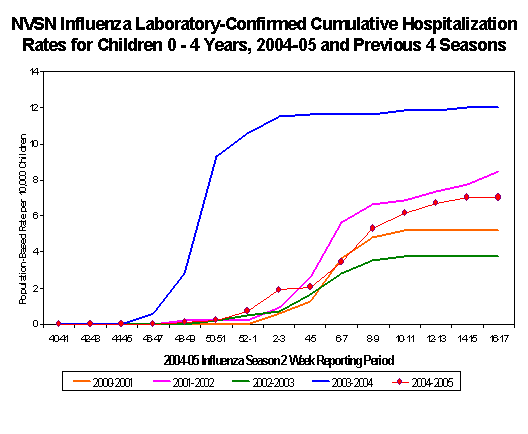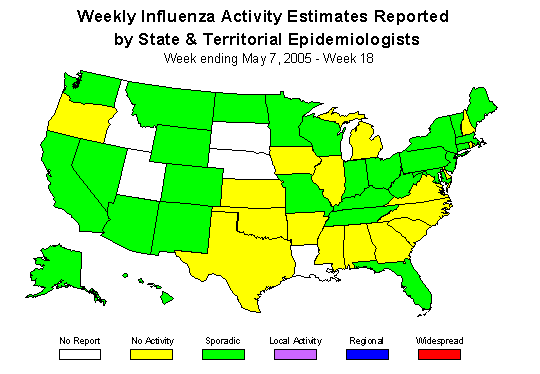Error processing SSI file
Error processing SSI file
Weekly Report: Influenza Summary Update
Week ending May 7, 2005-Week 18
Error processing SSI fileThe following information may be quoted:
Synopsis:
Influenza activity in the United States peaked in early February and continued to decline during week 18 (May 1-7, 2005)*. Twenty-seven (3.9%) specimens tested by U.S. World Health Organization (WHO) and National Respiratory and Enteric Virus Surveillance System (NREVSS) collaborating laboratories were positive for influenza viruses. The proportion of patient visits to sentinel providers for influenza-like illness (ILI) was below the national baseline. The proportion of deaths attributed to pneumonia and influenza was below the epidemic threshold. There have been 33 influenza-associated pediatric deaths reported to CDC this season. For week 18, there were no reports of widespread, regional, or local influenza activity. Twenty-eight states and New York City reported sporadic activity. Seventeen states and the District of Columbia reported no influenza activity.
Laboratory Surveillance*:
During week 18, WHO and NREVSS laboratories in the United States reported testing 691 specimens for influenza viruses, of which 27 (3.9%) were positive. Of these, 10 were influenza A(H3N2) viruses, 2 were influenza A viruses that were not subtyped, and 15 were influenza B viruses.
Since October 3, WHO and NREVSS laboratories in the United States have tested a total of 145,642 specimens for influenza viruses and 22,557 (15.5%) were positive. Among the 22,557 influenza viruses, 17,197 (76.2%) were influenza A viruses and 5,360 (23.8%) were influenza B viruses. Five thousand five hundred seventy-nine (32.4%) of the 17,197 influenza A viruses have been subtyped: 5,563 (99.7%) were influenza A(H3N2) and 16 (0.3%) were influenza A(H1) viruses. The percentage of specimens testing positive for influenza during the last 3 weeks (weeks 16-18) has ranged from 0.5% in the West South Central region to 9.7% in the Mountain region**. Nationally, influenza B viruses became more frequently reported than influenza A viruses during the week ending March 26 and have predominated each week since then.
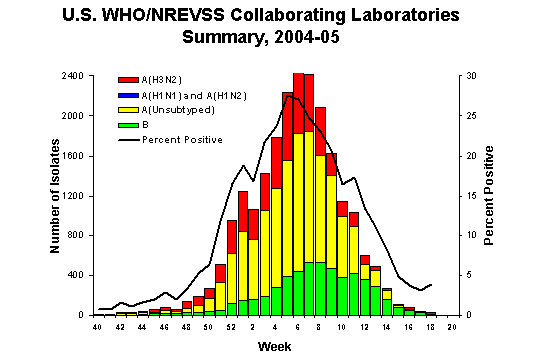
Antigenic Characterization:
CDC has antigenically characterized 812 influenza viruses collected by U.S. laboratories since October 1, 2004: 6 influenza A(H1) viruses, 541 influenza A(H3N2) viruses, and 265 influenza B viruses. The hemagglutinin proteins of the influenza A(H1) viruses were similar antigenically to the hemagglutinin of the vaccine strain A/New Caledonia/20/99. One hundred fifty-four (28%) of the 541 influenza A(H3N2) isolates were characterized as antigenically similar to A/Wyoming/3/2003, which is the A/Fujian/411/2002-like (H3N2) component of the 2004-05 influenza vaccine, and 387 (72%) were characterized as A/California/7/2004-like. One hundred seventy-four of the influenza B viruses isolated this season belong to the B/Yamagata lineage and were characterized as B/Shanghai/361/2002-like, which is the influenza B component recommended for the 2004-05 influenza vaccine, and 33 showed somewhat reduced titers to ferret antisera produced against B/Shanghai/361/2002. Fifty-eight influenza B viruses belong to the B/Victoria lineage.
Influenza B viruses currently circulating can be divided into two antigenically and genetically distinct lineages represented by B/Yamagata/16/88 and B/Victoria/2/87 viruses. B/Yamagata lineage viruses circulated widely between 1990 and 2001, during which time B/Victoria-like viruses were not identified outside of Asia. However, between March 2001 and October 2003, B/Victoria-like viruses predominated in many countries, including the United States, and the vaccine strains were changed accordingly. While both Victoria lineage and Yamagata lineage viruses have been reported worldwide during the past year, Yamagata lineage viruses have once again become predominant.
Pneumonia and Influenza (P&I) Mortality Surveillance*:
During week 18, 7.4% of all deaths reported by the vital statistics offices of 122 U.S. cities were attributed to pneumonia or influenza. This percentage is below the epidemic threshold of 7.6% for week 18.
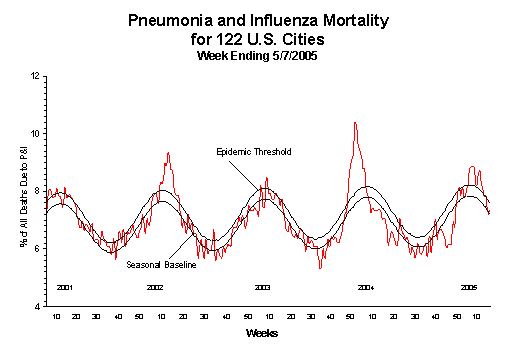
Influenza-Associated Pediatric Mortality*:
During week 18, one pediatric death was reported to CDC. For the entire season, 33 pediatric deaths have been reported to CDC from 13 states (California, Colorado, Florida, Georgia, Iowa, Maine, Massachusetts, Mississippi, New Jersey, New York, Ohio, Pennsylvania, and Vermont) and New York City; all deaths were reported during January-May.
Influenza-Associated Pediatric Hospitalizations:
Laboratory-confirmed influenza-associated pediatric hospitalizations are monitored in two population-based surveillance networks?/sup>: the Emerging Infections Program (EIP) and the New Vaccine Surveillance Network (NVSN). During October 3, 2004朅pril 30, 2005唵, the preliminary influenza-associated hospitalization rate for children 0? years old reported by NVSN and EIP was 7.0 and 2.8 per 10,000, respectively. EIP also monitors hospitalizations in children aged 5-17 years, and the preliminary influenza-associated hospitalization rate for this age group was 0.5 per 10,000. The overall hospitalization rate reported by EIP for children aged 0-17 years was 1.2 per 10,000. In years 2000?004, the end-of-season hospitalization rate for NVSN ranged from 3.7 (2002-03) to 12 (2003-04) per 10,000 children. The 2003-04 end of season hospitalization rate for EIP was 8.9 per 10,000 children aged 0-4 years¶ and 0.8 per 10,000 for children aged 5-17 years. The difference in rates between NVSN and EIP may be due to different case-finding methods and the different populations monitored. For a summary of the methods used in each system, please refer to the surveillance methods in the Flu Activity section of the CDC influenza website.
Influenza-like Illness Surveillance*:
During week 18, 1.2%¶¶ of patient visits to U.S. sentinel providers were due to ILI. This percentage is below the national baseline of 2.5%. Regional percentages ranged from 0.3% in the New England region to 2.3% in the Pacific region. Due to wide variability in regional level data, it is not appropriate to apply the national baseline to regional level data.
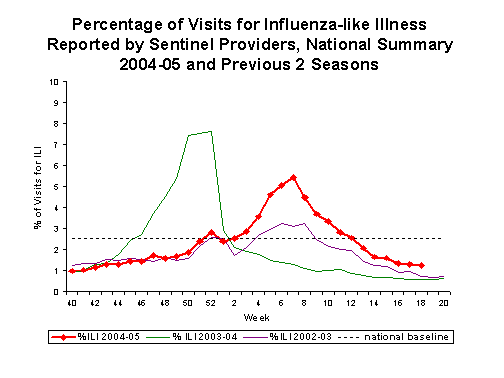
View
Chart Data
| View Full Screen
Influenza Activity as Assessed by State and Territorial Epidemiologists*:
There were no reports of widespread, regional, or local influenza activity during week 18. Twenty-eight states (Alaska, Arizona, California, Colorado, Connecticut, Florida, Hawaii, Indiana, Kentucky, Maine, Maryland, Massachusetts, Minnesota, Missouri, Montana, Nevada, New Jersey, New Mexico, New York, North Dakota, Ohio, Pennsylvania, Tennessee, Vermont, Washington, West Virginia, Wisconsin, and Wyoming) and New York City reported sporadic activity. Seventeen states (Alabama, Arkansas, Delaware, Georgia, Illinois, Iowa, Kansas, Michigan, Mississippi, New Hampshire, North Carolina, Oklahoma, Oregon, Rhode Island, South Carolina, Texas, and Virginia) and the District of Columbia reported no influenza activity. Idaho, Louisiana, Nebraska, South Dakota, and Utah did not report.
--------------------------------------------------------------------------------
Report prepared: May 12, 2005
Error processing SSI file